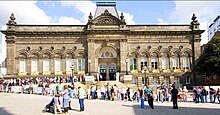Leeds Mechanics' Institute was a mechanics' institute founded in 1824 in Leeds, West Yorkshire, England,[1] and is one of the predecessor institutions of Leeds Beckett University[2] and Leeds Arts University.

History edit
The institute was founded by members of the Leeds Philosophical and Literary Society who wished to offer educational opportunities to the working class. Initially it occupied two rooms, a library and a lecture room, in a house on Park Row.[3][4][5]
This section needs expansion. You can help by adding to it. (December 2023) |
By 1907 most further education in Leeds was in the hands of the council, with the establishment of the Leeds College of Art, Leeds College of Technology (later Kitson College) and Leeds College of Commerce (later Park Lane College).[5] The main activities of the Leeds Institute, as it was now named, after 1907 included a lecture series, a library for its subscribers, and a cafe. The Leeds Institute struggled financially and in 1912 obtained the permission of the Charity Commission to sell its building and land to Leeds Corporation, for a sum ("not less than £39,000") large enough to clear its debts. It arranged to rent the building from the corporation. In 1940, the Leeds Institute had a dwindling membership and was unable, due to war-time restrictions, to hold its usual evening lectures. It went into voluntary liquidation and ceased to exist, with the lease on the building being surrendered to the landlord, Leeds Education Committee, for £2,310 9s 6d on 21 May 1940.[5]
A 2019 thesis from the University of Huddersfield includes a "genealogy" diagram showing the intermediate stages by which the Mechanics' Institution (its initial name) led to the formation of Leeds Beckett University and Leeds Arts University, while its premises now house Leeds City Museum.[6]: 265
Building edit
The Leeds Mechanics' Institute building, designed by Cuthbert Brodrick, was built in 1865–1868 in Cookridge Street.[7] The building is now grade II* listed,[8] and since 2008 has been the home of Leeds City Museum.[9] Before housing the museum, the building had several educational and cultural uses, including housing Leeds Civic Theatre and some departments of what was then the Leeds College of Music.
References edit
- ^ Garner, A. D.; Jenkins, E. W. (June 1984). "The English Mechanics' Institutes: The case of Leeds 1824–42". History of Education. 13 (2): 139–152. doi:10.1080/0046760840130204.
- ^ "History and Heritage". Leeds Beckett University. Retrieved 11 December 2023.
- ^ Scaife, Tony (13 January 2022). "The Mechanics' Institute: Part I – Cultivating Minds". The Secret Library: Leeds Libraries Heritage Blog. Leeds Libraries. Retrieved 11 December 2023.
- ^ Scaife, Tony (10 February 2022). "The Mechanics' Institute: Part II – "Commensurate with the growing intelligence and prosperity of the people."". The Secret Library: Leeds Libraries Heritage Blog. Leeds Libraries. Retrieved 11 December 2023.
- ^ a b c Scaife, Tony (7 April 2022). "The Mechanics' Institute: Part III – "…In no small measure to contribute…to the advancement of the community."". The Secret Library: Leeds Libraries Heritage Blog. Leeds Libraries. Retrieved 11 December 2023.
- ^ Hartley, Eve Alexandra (2019). The Cultural Legacy of the Mechanics' Institute Movement in the North of England (PDF) (PhD thesis). University of Huddersfield. Retrieved 11 December 2023.
- ^ Wrathmell, Susan; Minnis, John; Douglas, Janet (2005). "Leeds Institute". Leeds. Pevsner architectural guides. New Haven, Conn.: Yale Univ. Press. pp. 72–73. ISBN 9780300107364.
- ^ Historic England. "Leeds City Mueum (1375225)". National Heritage List for England. Retrieved 11 December 2023.
- ^ "Leeds Institute, now City Museum, by Cuthbert Brodrick (1821-1905)". victorianweb.org. Retrieved 11 December 2023.
53°48′06″N 01°32′49″W / 53.80167°N 1.54694°W